The Interplay of Autoclaving with Oxalate as Pretreatment Technique in the View of Bioethanol Production Based on Corn Stover
Abstract
:1. Introduction
2. Materials and Methods
2.1. Sampling and Processing of CS Biomass
2.2. Autoclave-Assisted Oxalate Pretreatment
2.3. Ultrasonic-Assisted Oxalate Pretreatment
2.4. Estimation of Lignin, Hemicellulose, and Cellulose
2.5. Characterization of Pretreated Samples
2.6. Enzymatic Saccharification
2.7. Modeling and Statistical Data Analysis
2.8. Fermentation Process
3. Results and Discussion
3.1. Combined Physical and Chemical Pretreatment
3.2. Effect of Physicochemical Pretreatments on CS
3.2.1. Composition of CS and Pretreated CS
3.2.2. Fourier Transform Infrared Spectrum Analysis
3.2.3. Elemental Characteristics
3.2.4. Structural Characteristics
3.2.5. Morphological Features
3.2.6. Thermal Stability
3.3. Enzymatic Saccharification
3.4. Optimization of Pretreatment Operating Conditions Using Response Surface Methodology
3.5. Statistical Analysis
3.6. Optimization of the Glucose Yield
3.7. Fermentation Process into Bioethanol
3.8. Overall Mass Balance
4. Conclusions
Author Contributions
Funding
Institutional Review Board Statement
Informed Consent Statement
Data Availability Statement
Acknowledgments
Conflicts of Interest
References
- Näyhä, A. Transition in the Finnish forest-based sector: Company perspectives on the bioeconomy, circular economy and sustainability. J. Clean. Prod. 2019, 209, 1294–1306. [Google Scholar] [CrossRef]
- Ko, C.-H.; Yang, B.-Y.; Lin, L.-D.; Chang, F.-C.; Chen, W.-H.I. Impact of pretreatment methods on production of bioethanol and nanocrystalline cellulose. J. Clean. Prod. 2020, 254, 119914. [Google Scholar] [CrossRef]
- Hamelin, L.; Borzęcka, M.; Kozak, M.; Pudełko, R. A spatial approach to bioeconomy: Quantifying the residual biomass potential in the EU-27. Renew. Sustain. Energy Rev. 2019, 100, 127–142. [Google Scholar] [CrossRef]
- Cybulska, I.; Brudecki, G.; Schmidt, J.E.; Tomsen, M.H. Organosolv Fractionation of Palm Tree Residues Organosolv fractionation of palm tree residues. Energy Procedia 2015, 75, 742–747. [Google Scholar] [CrossRef] [Green Version]
- Abd Elhafez, S.; El-Maghraby, A.; Taha, N. Adsorption Studies of Cationic Dye on Raw and Modified Sugarcane Bagasse from Aqueous Solutions: Kinetic and Isotherm Aspects. Egypt. J. Chem. 2021, 64, 1593–1600. [Google Scholar]
- Hilgers, R.; Erven, G.; Boerkamp, V.; Sulaeva, I.; Potthast, A.; Kabel, M.A.; Vincken, J.-P. Understanding laccase/HBT-catalyzed grass delignification at the molecular level. Green Chem. 2020, 22, 1735–1746. [Google Scholar] [CrossRef]
- Elhafez, S.A.; Hamad, H.A.; Zaatout, A.A.; Malash, G.F. Management of agricultural waste for removal of heavy metals from aqueous solution: Adsorption behaviors, adsorption mechanisms, environmental protection, and techno-economic analysis. Environ. Sci. Pollut. Res. 2017, 24, 1397–1415. [Google Scholar] [CrossRef]
- Gill, M.K.; Kocher, G.S.; Panesar, A.S. Optimization of acid-mediated delignification of corn stover, an agriculture residue carbohydrate polymer for improved ethanol production. Carbohydr. Polym. Technol. Appl. 2021, 2, 100029. [Google Scholar]
- Fírvida, I.; del Río, P.G.; Gullón, P.; Gullón, B.; Garrote, G.; Romaní, A. Alternative Lime Pretreatment of Corn Stover for Second-Generation Bioethanol Production. Agronomy 2021, 11, 155. [Google Scholar] [CrossRef]
- Taha, N.; Abd Elhafez, S.; El-Maghraby, A. Chemical and Physical Preparation of Activated Carbon Using Raw. Glob. NEST J. 2016, 18, 402–415. [Google Scholar]
- Mohapatra, S.; Jyotsna, S.; Thatoi, H. Physicochemical characterization, modelling and optimization of ultrasono-assisted acid pretreatment of two Pennisetum sp. using Taguchi and artificial neural networking for enhanced deligni fication. J. Environ. Manag. 2017, 187, 537–549. [Google Scholar] [CrossRef] [PubMed]
- Tang, W.; Wu, X.; Huang, C.; Ling, Z.; Lai, C.; Yong, Q. Revealing the influence of metallic chlorides pretreatment on chemical structures of lignin and enzymatic hydrolysis of waste wheat straw. Bioresour. Technol. 2021, 342, 125983. [Google Scholar] [CrossRef]
- Zhao, X.; Meng, X.; Ragauskas, A.J.; Lai, C.; Ling, Z.; Haung, C.; Yong, Q. Unlocking the secret of lignin-enzyme interactions: Recent advances in developing state-of-the-art analytical techniques. Biotechnol. Adv. 2021, 107830. [Google Scholar] [CrossRef]
- Shaoni, S.; Shaolong, S.; Xuefei, C.; Runcang, S. Bioresource Technology The role of pretreatment in improving the enzymatic hydrolysis of lignocellulosic materials. Bioresour. Technol. 2016, 199, 49–58. [Google Scholar]
- Lin, W.; Yang, J.; Zheng, Y.; Huang, C.; Yong, Q. Understanding the efects of diferent residual lignin fractions in acid-pretreated bamboo residues on its enzymatic digestibility. Biotechnol. Biofuels 2021, 14, 143. [Google Scholar] [CrossRef] [PubMed]
- Asim, A.M.; Uroos, M.; Muhammad, N. Extraction of lignin and quantitative sugar release from biomass using efficient and cost-effective pyridinium protic ionic liquids. RSC Adv. 2020, 10, 44003. [Google Scholar] [CrossRef]
- Chen, M.; Zhao, J.; Xia, L. Comparison of four different chemical pretreatments of corn stover for enhancing enzymatic digestibility. Biomass Bioenergy 2009, 33, 1381–1385. [Google Scholar] [CrossRef]
- Li, L.; Yu, L.; Wu, Z.; Hu, Y. Delignification of poplar wood with lactic acid-based deep eutectic solvents. Wood Res. 2019, 64, 499–514. [Google Scholar]
- Yuan, Z.; Wen, Y.; Li, G. Bioresource Technology Production of bioethanol and value added compounds from wheat straw through combined alkaline/alkaline-peroxide pretreatment. Bioresour. Technol. 2018, 259, 228–236. [Google Scholar] [CrossRef]
- Ping, W.; Chaoqi, L.; Juan, C.; Qingqiang, Y.; Weiwei, H.; Yang, L.; Xiaowei, D.; Tianzeng, G.; Fushan, L. Effect of physicochemical pretreatments plus enzymatic hydrolysis on the composition and morphologic structure of corn straw. Renew. Energy 2019, 138, 502–508. [Google Scholar]
- Chotirotsukon, C.; Raita, M.; Champreda, V.; Laosiripojana, N. Fractionation of sugarcane trash by oxalic-acid catalyzed glycerol-based organosolv followed by mild solvent delignification. Ind. Crop. Prod. 2019, 141, 111753. [Google Scholar] [CrossRef]
- Van Soest, P.J.; Robertson, J.B.; Lewis, B.A. Methods for Dietary Fiber, Neutral Detergent Fiber, and Nonstarch Polysaccharides in Relation to Animal Nutrition. J. Dairy Sci. 1991, 74, 3583–3597. [Google Scholar] [CrossRef]
- AbdElhafez, S.E.; Abo-Zahhad, E.M.; El-Shazly, M.; El-Shazly, A.H.; El-Kady, M.F. Experimental Investigate of Heat Transfer for Graphene/Water Nanofluid in Micro Heat Exchanger. AIP Conf. Proc. 2017, 1814, 020014–1:13. [Google Scholar]
- Segal, L.; Creely, J.J.; Martin, A.E., Jr.; Conrad, C.M. Empirical Method for Estimating the Degree of Crystallinity of Native Cellulose Using the X-Ray Diffractometer. Text. Res. J. 1958, 29, 786–794. [Google Scholar] [CrossRef]
- Meethit, P.; Ratanaprasit, P.; Sakdaronnarong, C. Candida shehatae and Saccharomyces cerevisiae work synergistically to improve ethanol fermentation from sugarcane bagasse and rice straw hydrolysate in immobilized cell bioreactor. Eng. Life Sci. 2016, 16, 706–719. [Google Scholar] [CrossRef]
- Caputi, A.; Ueda, M.; Brown, T. Spectrophotometric Determination of Ethanol in Wine. Am. J. Enol. Vitic. 1968, 19, 160–165. [Google Scholar]
- Hassaan, M.A.; Pantelo, A.; Luigi, T.; Elkatory, M.R.; Ali, R.M.; El Nemr, A. Enhancement of biogas production via green ZnO nanoparticles: Experimental results of selected herbaceous crops. Chem. Eng. Commun. 2021, 208, 242–255. [Google Scholar] [CrossRef]
- El-Sayed, E.M.; Hamad, H.A.; Ali, R.M. Journey from ceramic waste to highly efficient toxic dye adsorption from aqueous solutions via one-pot synthesis of CaSO4 rod-shape with silica. J. Mater. Res. Technol. 2020, 6, 16051–16063. [Google Scholar] [CrossRef]
- Hamad, H.; Bailón-García, E.; Morales-Torres, S.; Carrasco-Marín, F.; Pérez-Cadenas, A.F.; Maldonado, F.J. Physicochemical properties of new cellulose-TiO2 composites for the removal of water pollutants: Developing specific interactions and performances by cellulose functionalization. J. Environ. Chem. Eng. 2018, 6, 5032–5041. [Google Scholar] [CrossRef]
- Ali, M.R.; Elkatory, M.R.; Hassaan, M.A.; Amer, K.; El Geiheini, A. Highly Crystalline Heterogeneous Catalyst Synthesis from Industrial Waste for Sustainable Biodiesel Production. Egypt. J. Chem. 2020, 63, 1161–1178. [Google Scholar] [CrossRef]
- Mohamed, M.A.A.; Elessawy, N.A.; Carrasco-Marín, F.; Hamad, H.A.F. A novel one-pot facile economic approach for the mass synthesis of exfoliated multilayered nitrogen-doped graphene-like nanosheets: New insights into the mechanistic study. Phys. Chem. Chem. Phys. 2019, 21, 13611–13622. [Google Scholar] [CrossRef]
- Ali, R.M.; Elkatory, M.R.; Hamad, H. Highly active and stable magnetically recyclable CuFe2O4 as a heterogenous catalyst for efficient conversion of waste frying oil to biodiesel. Fuel 2020, 268, 117297. [Google Scholar] [CrossRef]
- Hassaan, M.; Elkatory, M.R.; Ali, R.M.; El Nemr, A. Photocatalytic degradation of reactive black 5 using photo-fenton and ZnO nanoparticles under UV irradiation. Egypt. J. Chem. 2020, 63, 1443–1459. [Google Scholar] [CrossRef]
- Hamad, A.A.; Hassouna, M.S.; Shalaby, T.I.; Elkady, M.F.; Abd Elkawi, M.A.; Hamad, H.A. Electrospun cellulose acetate nanofiber incorporated with hydroxyapatite for removal of heavy metals. Int. J. Biol. Macromol. 2020, 151, 1313. [Google Scholar] [CrossRef]
- Kamel, D.A.; Farag, H.A.; Amin, N.K.; Zaatout, A.A.; Ali, R.M. Smart utilization of jatropha (Jatropha curcas Linnaeus) seeds for biodiesel production: Optimization and mechanism. Ind. Crop. Prod. 2018, 111, 407–413. [Google Scholar] [CrossRef]
- Bassyouni, D.; Mohamed, M.E.; El-Ashtoukhy, E.; Abd El-Latif, M.; Zaatout, A.; Hamad, H. Fabrication and characterization of electrospun Fe3O4/o-MWCNTs/polyamide 6 hybrid nanofibrous membrane composite as an efficient and recoverable adsorbent for removal of Pb (II). Microchem. J. 2019, 149, 103998. [Google Scholar] [CrossRef]
- Hamadi, A.; Yeddou-Mezenner, N.; Azeddine, L.; Ali, R.M.; Hamd, H. Upgrading of agro-industrial green biomass residues from chocolate industry for adsorption process: Diffusion and mechanistic insights. J. Food Sci. Technol. 2021, 58, 1081–1092. [Google Scholar] [CrossRef] [PubMed]
- Eltarahony, M.; Abu-Serie, M.; Hamad, H.; Zaki, S.; Abd-El-Haleem, D. Unveiling the role of novel biogenic functionalized CuFe hybrid nanocomposites in boosting anticancer, antimicrobial and biosorption activities. Sci. Rep. 2021, 11, 7790. [Google Scholar] [CrossRef] [PubMed]
- Ali, R.M.; Hamad, H.A.; Hussein, M.M.; Malash, G.F. Potential of using green adsorbent of heavy metal removal from aqueous solutions: Adsorption kinetics, isotherm, thermodynamic, mechanism and economic analysis. Ecol. Eng. 2016, 91, 317–332. [Google Scholar] [CrossRef]
- Belouadah, Z.; Ati, A.; Rokbi, M. Characterization of new natural cellulosic fiber from Lygeum. Carbohydr. Polym. 2018, 134, 429–437. [Google Scholar] [CrossRef]
- Hamad, H.; Castelo-Quibén, J.; Morales-Torres, S.; Carrasco-Marín, F.; Pérez-Cadenas, A.F.; Maldonado, F.J. On the Interactions and Synergism between Phases of Carbon–Phosphorus–Titanium Composites Synthetized from Cellulose for the Removal of the Orange-G Dye. Materials 2018, 11, 1766. [Google Scholar] [CrossRef] [Green Version]
- Zhou, J.; Hualin Chen, H.; Thring, R.W.; Arocena, J.M. Chemical Pretreatment of Rice Straw Biochar: Efect on Biochar Properties and Hexavalent Chromium Adsorption. Int. J. Environ. Res. 2019, 13, 91–105. [Google Scholar] [CrossRef]
- Ibrahim, Q.; Arauzo, P.J.; Kruse, A. The effect of using different acids to catalyze the prehydrolysis stage on the organosolv delignification of beech wood in two-stage process. Renew. Energy 2020, 153, 1479–1487. [Google Scholar] [CrossRef]
- Eng, K.N.; Ta, Y.W.; Cornelius, B.T.L.L.; Zi, Y.P.; Yu-Loong, L.; Luther, Y.W.F.; Alessandra, P.; Lee, F.S.; Wen, H.T.; Nik, N.N.D.; et al. Potential use of pure and diluted choline chloride-based deep eutectic solvent in delignification of oil palm fronds. Process Saf. Environ. Prot. 2019, 123, 190–198. [Google Scholar]
- Loow, Y.L.; Ta, Y.W. Transformation of oil palm fronds into pentose sugars using copper (II) sulfate pentahydrate with the assistance of chemical additive. J. Environ. Manag. 2017, 15, 192–203. [Google Scholar] [CrossRef] [PubMed]
- Gabhane, J.; Prince, W.S.P.M.; Vaidya, A.N.; Mahapatra, K.; Chakrabarti, T. Influence of heating source on the efficacy of lignocellulosic pretreatment—A cellulosic ethanol perspective. Biomass Bioenergy 2011, 35, 96–102. [Google Scholar] [CrossRef]
- Hamad, H.; Bailón-García, E.; Morales-Torres, S.; Carrasco-Marín, F.; Pérez-Cadenas, A.F.; Maldonado, F.J. Functionalized cellulose for the controlled synthesis of novel carbon-ti nanocomposites: Physicochemical and photocatalytic properties. Nanomaterials 2020, 10, 729. [Google Scholar] [CrossRef] [Green Version]
- Ali, A.Y.M.; El-Shazly, A.H.; El-Kady, M.F.; AbdElhafez, S.E. Evaluation of surfactants on thermo-physical properties of Magnesia-oil nanofluid. Mater. Sci. Forum 2018, 928, 106–112. [Google Scholar] [CrossRef]
- Watkins, D.; Nuruddin, M.; Hosur, M.; Tcherbi-Narteh, A.; Jeelani, S. Extraction and characterization of lignin from different biomass resources. J. Mater. Res. Technol. 2015, 4, 26–32. [Google Scholar] [CrossRef] [Green Version]
- Kwoczynski, Z.; Cmelík, J. Characterization of biomass wastes and its possibility of agriculture utilization due to biochar production by torrefaction process. J. Clean. Prod. 2021, 280, 124302. [Google Scholar] [CrossRef]
- Chen, H.; Yunni, Z.; Xinghu, D.; Yang, Z.; Longxiang, Y.; Xianzhi, M.; Jian, J.; Guigan, F.; Arthur, J.R. Modified alkaline peroxide pretreatment: An efficient path forward for bioethanol production from bamboo. Energy Convers. Manag. 2020, 224, 113365. [Google Scholar]
- Ashutosh, M.; Rui, K.; Bryon, S.D.; Brenna, A.B.; Sivakumar, P.; Jack, M.S.; Gregg, T.B. Alkaline Peroxide Delignification of Corn Stover. ACS Sustain. Chem. Eng. 2017, 5, 6310–6321. [Google Scholar]
- Stelte, W.; Clemons, C.; Holm, J.K.; Ahrenfeldt, J.; Henriksen, U.B.; Sanadi, A.R. Thermal transitions of the amorphous polymers in wheat straw. Ind. Crop. Prod. 2011, 34, 1053–1056. [Google Scholar] [CrossRef] [Green Version]
- Dharma, S.; Masjuki, H.H.; Hwai, C.O.; Sebayang, A.H.; Silitonga, A.S.; Kusumo, F.; Mahlia, T.M.I. Optimization of biodiesel production process for mixed Jatropha curcas-Ceiba pentandra biodiesel using response surface methodology. Energy Convers. Manag. 2016, 115, 178–190. [Google Scholar] [CrossRef]
- Milano, J.; Ong, H.C.; Masjuki, H.H.; Silitonga, A.S.; Chene, W.-H.; Kusumoa, F.; Dharma, S.; Sebayang, A.H. Optimization of biodiesel production by microwave irradiation-assisted transesterification for waste cooking oil-Calophyllum inophyllum oil via response surface methodology. Energy Convers. Manag. 2018, 158, 400–415. [Google Scholar] [CrossRef]

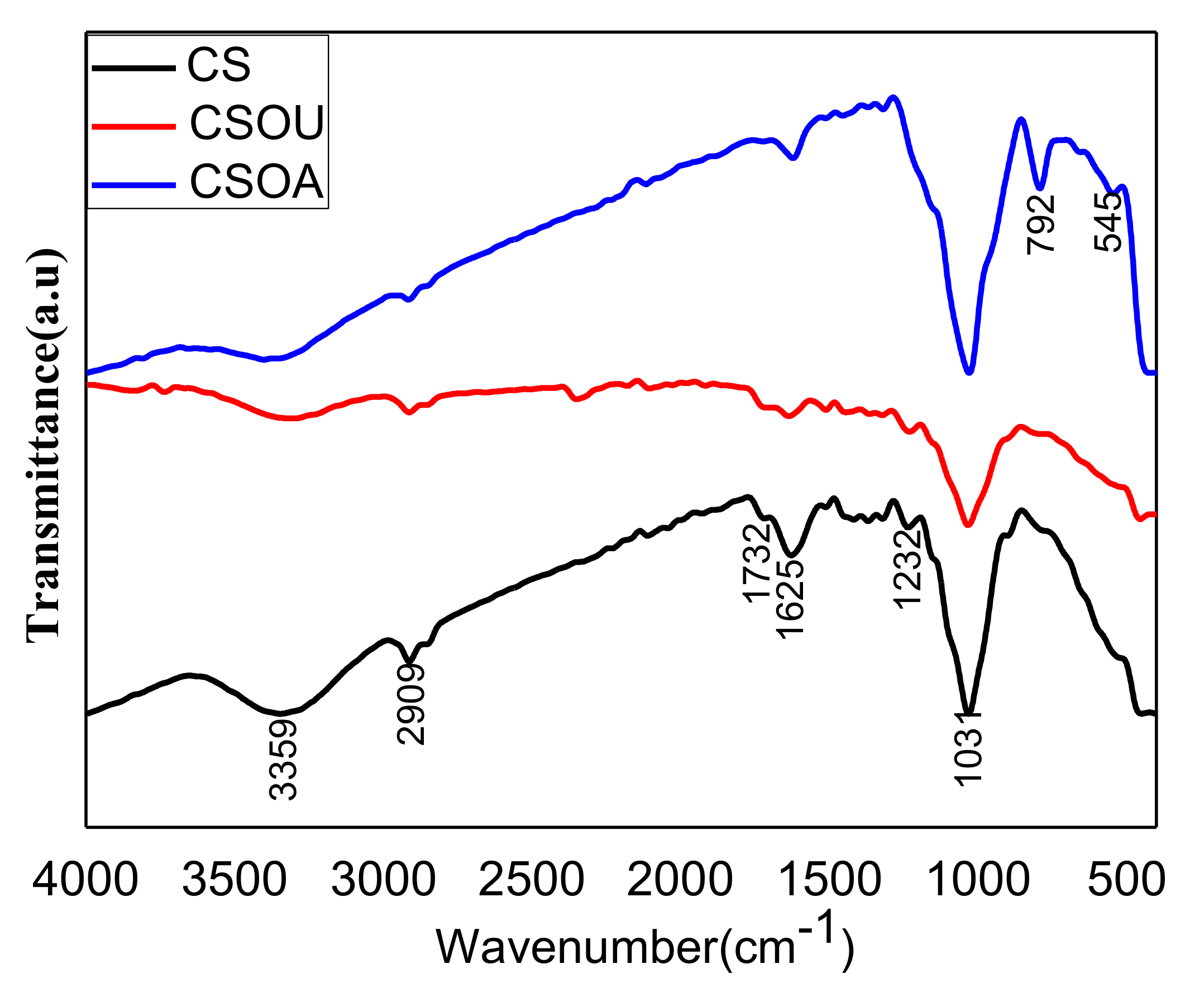

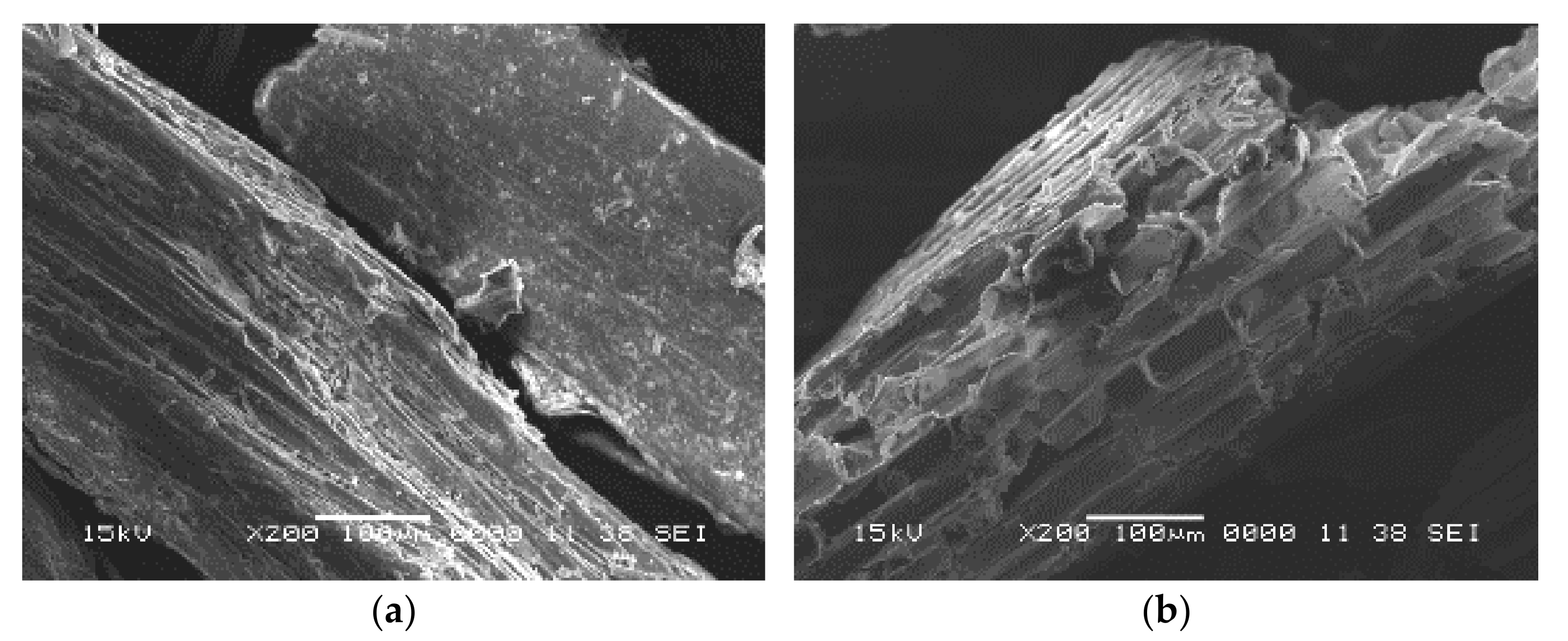


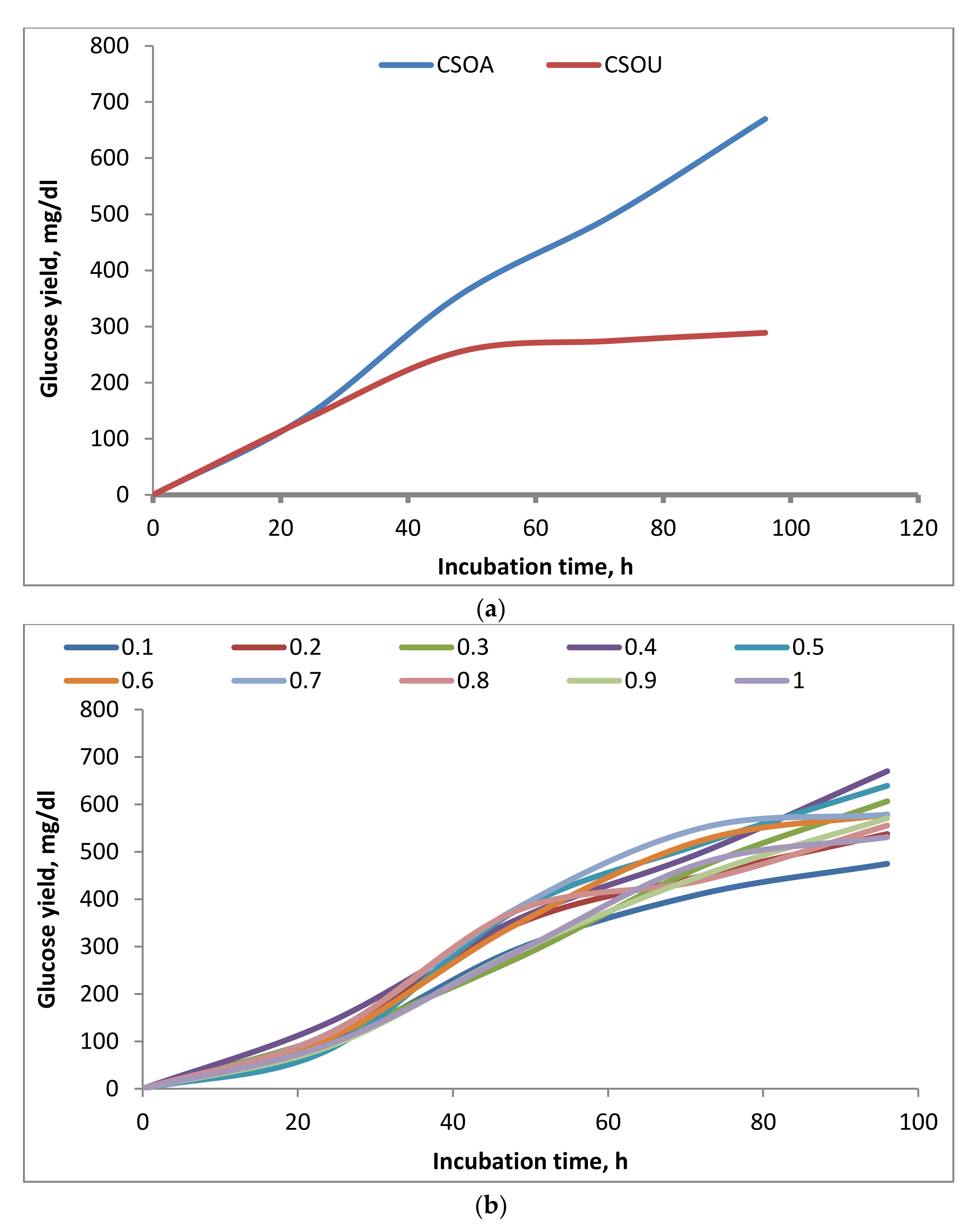

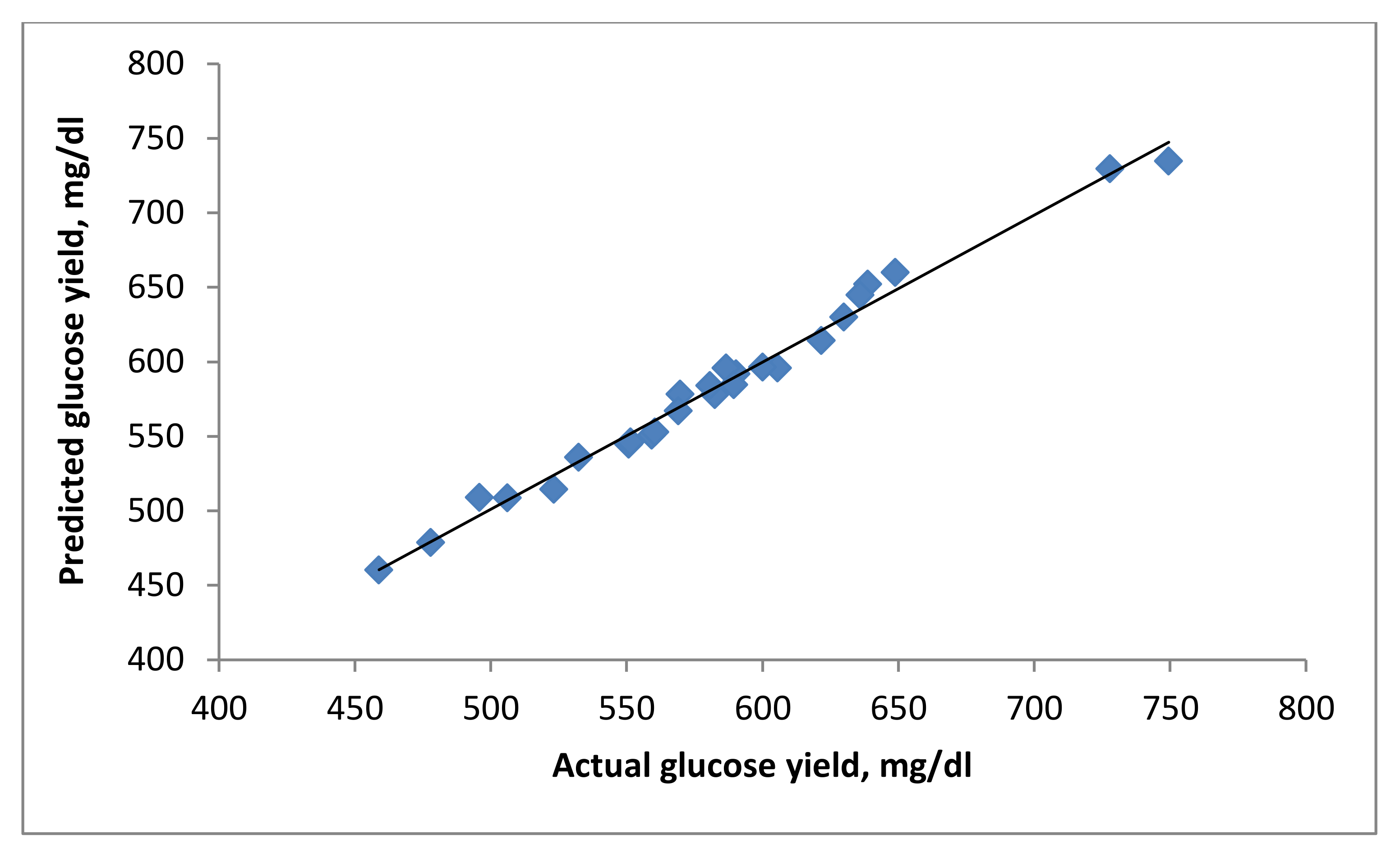

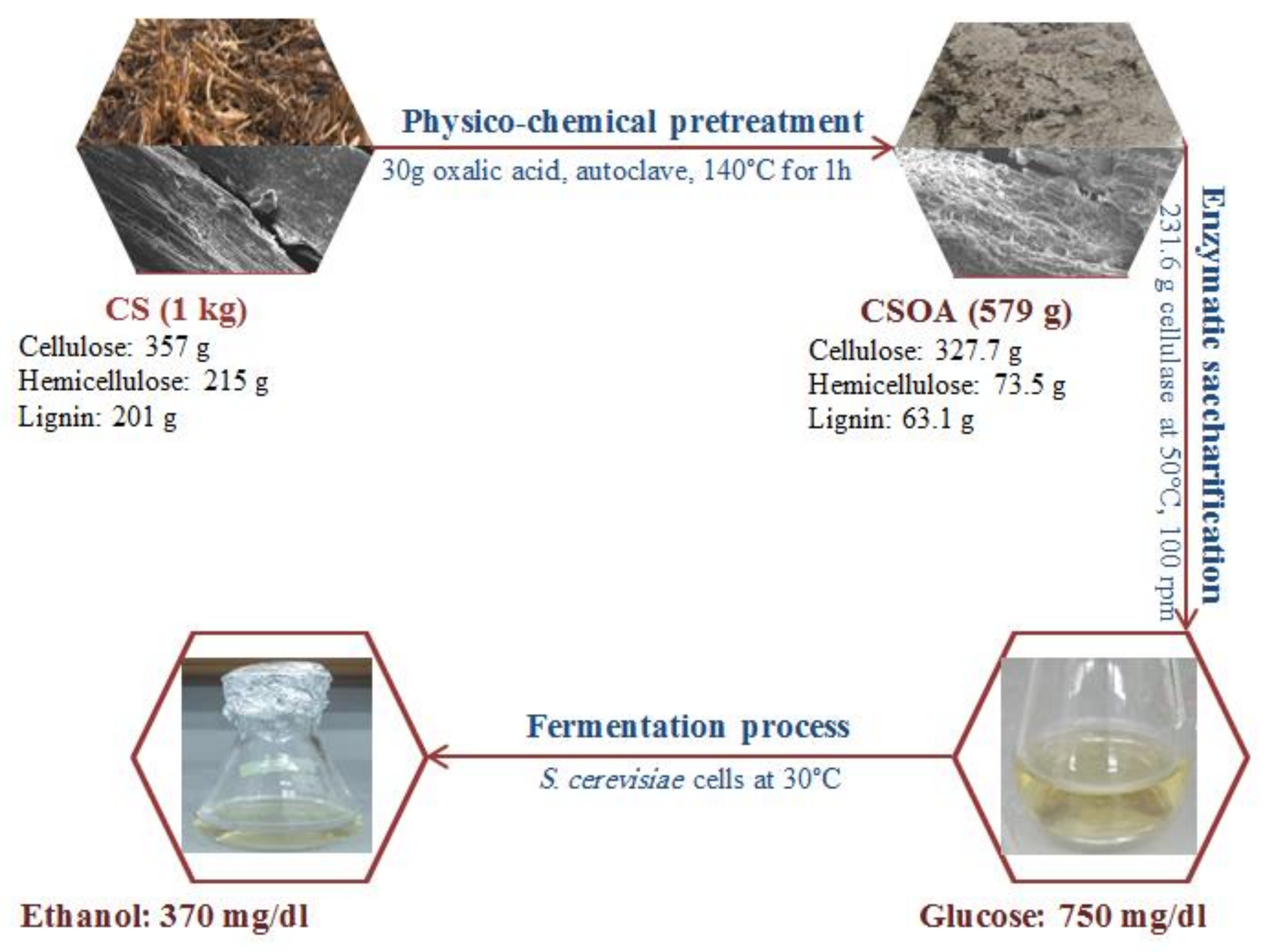
| Independent Variables | Levels | ||||
|---|---|---|---|---|---|
| −2 | −1 | 0 | 1 | 2 | |
| Temperature, °C (A) | 100 | 110 | 120 | 130 | 140 |
| Oxalic acid concentration, (w/v) (B) | 1 | 2 | 3 | 5 | 7 |
| Time, min (C) | 10 | 30 | 60 | 90 | 120 |
| Solid–liquid ratio (D) | 1:10 | 1:20 | 1:30 | 1:40 | 1:50 |
| Sample | N% | C% | H% | O% | H/C | O/C |
|---|---|---|---|---|---|---|
| CS | 1.08 | 41.63 | 5.747 | 51.543 | 0.138 | 1.24 |
| CSOU | 0.44 | 42.75 | 5.827 | 50.983 | 0.136 | 1.19 |
| CSOA | 0.46 | 43.65 | 5.852 | 50.038 | 0.134 | 1.15 |
| No. | Temp, °C | Acid Concentration, % | Time, Min | Solid to Liquid Ratio | Experimental Glucose Yield mg/dL | Predicted Glucose Yield mg/dL |
|---|---|---|---|---|---|---|
| 1 | 110 | 2 | 30 | 20 | 559.2 | 551.0 |
| 2 | 120 | 3 | 60 | 30 | 605. 6 | 595.8 |
| 3 | 110 | 2 | 30 | 40 | 523.3 | 514.7 |
| 4 | 120 | 7 | 60 | 30 | 590.4 | 592.1 |
| 5 | 120 | 3 | 10 | 30 | 569.7 | 579.0 |
| 6 | 130 | 2 | 90 | 20 | 569.0 | 567.2 |
| 7 | 110 | 2 | 90 | 20 | 458.9 | 460.5 |
| 8 | 110 | 5 | 90 | 20 | 582.6 | 578.0 |
| 9 | 120 | 3 | 120 | 30 | 560.4 | 553.0 |
| 10 | 120 | 3 | 60 | 30 | 589.6 | 595.8 |
| 11 | 130 | 2 | 30 | 40 | 648.8 | 660.2 |
| 12 | 130 | 5 | 30 | 40 | 621.7 | 614.4 |
| 13 | 110 | 2 | 90 | 40 | 477.9 | 479.0 |
| 14 | 110 | 5 | 30 | 40 | 506.2 | 508.7 |
| 15 | 110 | 5 | 30 | 20 | 550.7 | 544.9 |
| 16 | 130 | 2 | 30 | 20 | 630.0 | 630.1 |
| 17 | 130 | 5 | 90 | 40 | 727.8 | 729.7 |
| 18 | 120 | 3 | 60 | 50 | 589.5 | 584.6 |
| 19 | 100 | 3 | 60 | 30 | 495.9 | 509.3 |
| 20 | 130 | 5 | 30 | 20 | 580.7 | 584.3 |
| 21 | 110 | 5 | 90 | 40 | 600.0 | 596.4 |
| 22 | 130 | 2 | 90 | 40 | 638.8 | 652.1 |
| 23 | 130 | 5 | 90 | 20 | 635.9 | 644.9 |
| 24 | 140 | 3 | 60 | 30 | 749.5 | 734.9 |
| 25 | 120 | 1 | 60 | 30 | 551.4 | 546.2 |
| 26 | 120 | 3 | 60 | 10 | 532.4 | 536.1 |
| Coefficients | Standard Error | t-Stat | p-Value | |
|---|---|---|---|---|
| Intercept | 1364.124191 | 414.9045024 | 3.2878 | 0.00648567 |
| (A) Temp, °C | −14.48632433 | 6.305360802 | −2.2975 | 0.04038268 |
| (B) Acid concentration | 80.38672663 | 23.61128492 | 3.40459 | 0.00522522 |
| (C) Time, min | −5.163789976 | 1.22583554 | −4.2125 | 0.00120492 |
| (D) Solid to liquid ratio | −16.12015954 | 3.691088018 | −4.3673 | 0.0009165 |
| A2 | 0.065668409 | 0.025808449 | 2.54445 | 0.02572676 |
| B2 | −4.285919799 | 1.154182777 | −3.7134 | 0.00296246 |
| C2 | −0.009623862 | 0.00328985 | −2.9253 | 0.01271406 |
| D2 | -0.088706591 | 0.025808449 | −3.4371 | 0.00492061 |
| AB | −0.663406339 | 0.179896327 | −3.6877 | 0.0031047 |
| AC | 0.022972021 | 0.009159873 | 2.5079 | 0.0275138 |
| AD | 0.166002438 | 0.027479618 | 6.04093 | 5.83899×10−5 |
| BC | 0.685950396 | 0.060137908 | 11.4063 | 8.49391×10−8 |
| CD | 0.045617062 | 0.009159873 | 4.9801 | 0.0003198 |
Publisher’s Note: MDPI stays neutral with regard to jurisdictional claims in published maps and institutional affiliations. |
© 2021 by the authors. Licensee MDPI, Basel, Switzerland. This article is an open access article distributed under the terms and conditions of the Creative Commons Attribution (CC BY) license (https://creativecommons.org/licenses/by/4.0/).
Share and Cite
Hamdy, A.; Abd Elhafez, S.; Hamad, H.; Ali, R. The Interplay of Autoclaving with Oxalate as Pretreatment Technique in the View of Bioethanol Production Based on Corn Stover. Polymers 2021, 13, 3762. https://doi.org/10.3390/polym13213762
Hamdy A, Abd Elhafez S, Hamad H, Ali R. The Interplay of Autoclaving with Oxalate as Pretreatment Technique in the View of Bioethanol Production Based on Corn Stover. Polymers. 2021; 13(21):3762. https://doi.org/10.3390/polym13213762
Chicago/Turabian StyleHamdy, Ali, Sara Abd Elhafez, Hesham Hamad, and Rehab Ali. 2021. "The Interplay of Autoclaving with Oxalate as Pretreatment Technique in the View of Bioethanol Production Based on Corn Stover" Polymers 13, no. 21: 3762. https://doi.org/10.3390/polym13213762
APA StyleHamdy, A., Abd Elhafez, S., Hamad, H., & Ali, R. (2021). The Interplay of Autoclaving with Oxalate as Pretreatment Technique in the View of Bioethanol Production Based on Corn Stover. Polymers, 13(21), 3762. https://doi.org/10.3390/polym13213762






